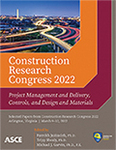Identification of the Barriers to Data-Centric Approach in the Construction Industry
Publication: Construction Research Congress 2022
ABSTRACT
With the advancement of technology, many industries are improving their workflows and productivity by embracing digital transformation, and specifically data-centric approaches. Construction, however, is often slower to adopt new technology and innovations. A data-centric approach can enrich project delivery value and streamline processes through applications of data science and emerging innovations, such as artificial intelligence. This study aims to identify the barriers to adopting data-centric approaches in the construction industry. Initially, a literature review on Building Information Modeling (BIM) implementation identified 35 barriers. Next, the barriers were organized and refined to be more specific to a data-centric approach with the help of expert focus group meetings. Finally, the barriers were categorized based on experts’ opinions into five categories: Process, Information, Financial, People, and Risk. The result of this study can help the construction industry move toward a more data-centric approach through the evaluation of approaches to overcome the identified barriers.
Get full access to this article
View all available purchase options and get full access to this chapter.
REFERENCES
Agarwal, R., Chandrasekaran, S., and Sridhar, M. (2016). Imagining construction’s digital future. McKinsey & Company.
Ahmed, S. (2018). “Barriers to implementation of building information modeling (BIM) to the construction industry: a review.” Journal of Civil Engineering and Construction, 7(2), 107–113.
Azhar, S. (2011). “Building Information Modeling (BIM): Trends, Benefits, Risks, and Challenges for the AEC Industry.” Leadership and Management in Engineering, 11, 241.
Bosch-Sijtsema, P., Isaksson, A., Lennartsson, M., and Linderoth, H. C. J. (2017). “Barriers and facilitators for BIM use among Swedish medium-sized contractors - ‘We wait until someone tells us to use it.’” Visualization in Engineering, 5(1), 3.
Camba, J. D., Contero, M., and Company, P. (2017). CAD Reusability and the Role of Modelin Information in the MBE Context. National Institute of Standards and Technology.
Eadie, R., Odeyinka, H., Browne, M., McKeown, C., and Yohanis, M. (2014). “Building information modelling adoption: an analysis of the barriers to implementation.” Journal of Engineering and Architecture, 2(1), 77–101.
Fitriani, H., Budiarto, A., Ajayi, S., and Idris, Y. (2019). “Implementing BIM in architecture, engineering and construction companies: Perceived benefits and barriers among local contractors in Palembang, Indonesia.”
Gardezi, S. S. S., Shafiq, N., Nuruddin, M. F., Farhan, S. A., and Umar, U. A. (2014). “Challenges for implementation of building information modeling (BIM) in Malaysian construction industry.” Applied Mechanics and Materials, Trans Tech Publ, 559–564.
Gartner. (2020). “Definition of Digitization - Gartner Information Technology Glossary.” Gartner, <https://www.gartner.com/en/information-technology/glossary/digitization>(Nov. 27, 2020).
Griego, R., Sampson, M., and Friedenthal, S. (2007). “INCOSE Model Based Systems Engineering (MBSE) Initiative.” In INCOSE 2007 Symposium.
Huang, R., Zhang, S., Bai, X., and Xu, C. (2014). “Multi-level structuralized model-based definition model based on machining features for manufacturing reuse of mechanical parts.” The International Journal of Advanced Manufacturing Technology, 75(5), 1035–1048.
Jensen, J. C., Chang, D. H., and Lee, E. A. (2011). “A model-based design methodology for cyber-physical systems.” 2011 7th International Wireless Communications and Mobile Computing Conference, 1666–1671.
Jin, R., Hancock, C. M., Tang, L., and Wanatowski, D. (2017). “BIM investment, returns, and risks in China’s AEC industries.” Journal of Construction Engineering and Management, 143(12), 04017089.
Khaja, M., Seo, J. D., and McArthur, J. J. (2016). “Optimizing BIM Metadata Manipulation Using Parametric Tools.” Procedia Engineering, ICSDEC 2016 – Integrating Data Science, Construction and Sustainability, 145, 259–266.
Liu, S., Xie, B., Tivendal, L., and Liu, C. (2015). “Critical barriers to BIM implementation in the AEC industry.” International Journal of Marketing Studies, 7(6), 162–171.
National BIM Standard. (2015). “National BIM Standard.” <https://www.nationalbimstandard.org/>(Aug. 3, 2020).
Newton, K., and Chileshe, N. (2012). Enablers and barriers of building information modelling (BIM) within South Australian construction organisations. PhD Thesis, University of New South Wales Sydney, Australia.
Oteng, D., Ansah, M. K., Kissi, E., and Eshun, B. T. B. (2018). “Barriers to the Adoption of Building Information Modeling in Developing Countries: The Case of Ghana.” 1st International Conference on Construction Futures.
Ruemler, S. P., Zimmerman, K. E., Hartman, N. W., Hedberg, T., and Feeny, A. B. (2017). “Promoting Model-based Definition to Establish a Complete Product Definition.” Journal of Manufacturing Science and Engineering, 139(5).
Solis, B., and Szymanski, J. (2016). The Race Against Digital Darwinism: Six Stages of Digital Transformation. A matuirty framework to advance technology roadmaps, business models, and processes to coompete in the digital economy. Altimeter@Prophet.
Tan, T., Chen, K., Xue, F., and Lu, W. (2019). “Barriers to Building Information Modeling (BIM) implementation in China’s prefabricated construction: An interpretive structural modeling (ISM) approach.” Journal of Cleaner Production, 219, 949–959.
Ullah, K., Lill, I., and Witt, E. (2019). “An Overview of BIM Adoption in the Construction Industry: Benefits and Barriers.” 10th Nordic Conference on Construction Economics and Organization, Emerald Reach Proceedings Series, I. Lill and E. Witt, eds., Emerald Publishing Limited, 297–303.
Varnosfaderani, M., and Aghajani-Delavar, M. (2017). “Enhancing Building Information Modeling by using IoT services.” International Conference on Contemporary Iran on Civil Engineering Architecture and Urban Development.
Verhoef, P. C., Broekhuizen, T., Bart, Y., Bhattacharya, A., Qi Dong, J., Fabian, N., and Haenlein, M. (2021). “Digital transformation: A multidisciplinary reflection and research agenda.” Journal of Business Research, 122, 889–901.
Won, J., Lee, G., Dossick, C., and Messner, J. (2013). “Where to Focus for Successful Adoption of Building Information Modeling within Organization.” Journal of Construction Engineering and Management, American Society of Civil Engineers, 139(11), 04013014.
Information & Authors
Information
Published In
History
Published online: Mar 7, 2022
Authors
Metrics & Citations
Metrics
Citations
Download citation
If you have the appropriate software installed, you can download article citation data to the citation manager of your choice. Simply select your manager software from the list below and click Download.
Cited by
- Devayani Y. Jahagirdar, Robert M. Leicht, Applications of Digital Twins for the Construction Process, Computing in Civil Engineering 2023, 10.1061/9780784485231.043, (357-363), (2024).
